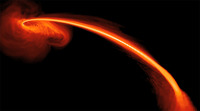







| BOOKS | F. A. Q. | ARTICLES | TALKS | ABOUT KEN | DONATE | BEYOND OUR KEN |
|---|
By Ken Croswell
Published on ScienceNOW (May 2, 2012)

Slaughtered star: a black hole (upper left) tears a helium-rich star to shreds. Credit: S. Gezari/Johns Hopkins University and J. Guillochon, UC Santa Cruz/NASA.
Some people seem born under an unlucky star. But some stars are equally unlucky themselves. Astronomers have spotted a star in another galaxy plunging toward a giant black hole and being ripped to shreds, sparking a flare so brilliant that observers detected it from a distance of 2.1 billion light-years. By watching the flare brighten and fade, scientists have achieved the unprecedented feat of reconstructing the life story of the doomed sun.
Giant black holes occupy the centers of most large galaxies, including our own, whose central black hole is 4 million times as massive as the Sun and swallows a star once every 10,000 to 100,000 years. Astronomers have recently seen black holes in several other galaxies rip stars apart. But the new drama is unique. "This is the first time where we're really seeing one of these events from start to finish," says astronomer Suvi Gezari of Johns Hopkins University in Baltimore, Maryland. "What was so spectacular was the fact that we actually could figure out what type of star was disrupted."
Astronomers first picked up a distress call from the constellation Draco in May 2010, when the Pan-STARRS 1 telescope in Hawaii spotted a flare at visible and near-infrared wavelengths. The scientists calculate that the black hole's gravity had torn the star apart a month earlier by pulling harder on one side of the star than the other. As stellar debris funneled into the black hole, gravity and friction roasted the star's remains until they emitted ultraviolet radiation, which NASA's GALEX satellite detected in June. The flare peaked in July 2010, outshining all the stars in the galaxy put together, and then faded, but was still aglow a year later.
As Gezari's team reports online today in Nature, the black hole is about 3 million times more massive than our Sun, slightly smaller than the Milky Way's central black hole, and marks the heart of a galaxy dimmer than our own. The black hole swallowed only about half the star, which lost a huge amount of energy by plummeting into the black hole. Because the laws of physics dictate that energy must be conserved, the rest of the star shot away from the black hole at enormous speed.
The team has also pieced together the life story of the unlucky star. Born roughly a billion years ago, it once generated energy as the Sun does, converting hydrogen into helium at its core. When the core filled with helium, the star became a red giant--a helium core surrounded by a puffy outer layer of hydrogen.
But the distant sun was doomed. Gezari doesn't know whether it was born in a bad orbit or another star's gravity kicked it into one, but the star began approaching the black hole. Before its fiery demise, when the star was about as far from its nemesis as Pluto is from the Sun, the black hole stripped off its hydrogen envelope. That left the star with only its helium core, which was a third of the Sun's diameter and bore a quarter of its mass. When the star ventured within 50 million kilometers, slightly closer than Mercury is to the Sun, the black hole tore it to pieces. Gezari and her colleagues can infer its composition because they detect helium but no hydrogen in its glowing remains.
"It's quite impressive," says astronomer Giuseppe Lodato of the University of Milan in Italy, who was not affiliated with the scientists who discovered the event. "They're able to infer quite a few details not just about the black hole, but also about the kind of star that has been disrupted."
Ironically, only in death could astronomers study the star's life: it was so distant that had it not been destroyed, no telescope could have seen it.
Ken Croswell earned his Ph.D. in astronomy from Harvard University and is the author of The Alchemy of the Heavens and The Lives of Stars.
"An engaging account of the continuing discovery of our Galaxy...wonderful." --Owen Gingerich, The New York Times Book Review. See all reviews of The Alchemy of the Heavens here.
"A stellar picture of what we know or guess about those distant lights."--Kirkus. See all reviews of The Lives of Stars here.
| BOOKS | F. A. Q. | ARTICLES | TALKS | ABOUT KEN | DONATE | BEYOND OUR KEN |
|---|